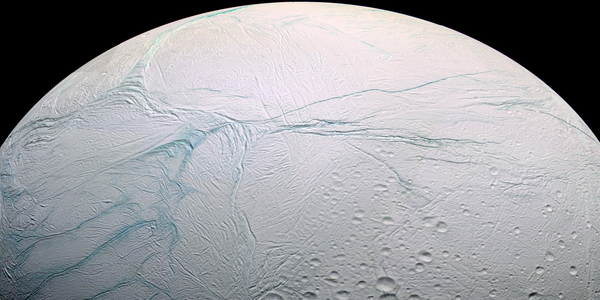One Of Saturn's Moons Contains Water, Could Contain Life

The search for life in our universe is dependent on technological advances and scientists learning exactly what it takes to make life. We now have a better idea of what is necessary, but we are still searching for areas that are possibly habitable. Fortunately, we may have finally had a break on that front. Scientists have discovered something on a distant moon that may just harbor extra terrestrial life, or at least the stuff to form it.
According to CNN, one of Saturn's moons apparently has an underground ocean. The Cassini spacecraft which has been orbiting the moon has taken measurements that have brought the discovery of this ocean to NASA scientists. Enceladus, the sixth largest moon of Saturn, appears to have an ocean that is possibly habitable or at least was habitable in the past. The ocean is at least the size of Lake Superior and is underneath a thick layer of ice. Water on other planets and moons in our solar system is pretty rare, and just a couple moons of Saturn and Jupiter are suspected to have oceans underneath their icy surfaces.
Enceladus's surface has ice thicknesses that vary from 30 miles thick to 18 to 24 miles thick, and underneath the ice is a rocky surface. The ocean under the ice is thought to be at least five miles deep and spread out in a lens shape over a rocky core. The coolest part is that based on new and previous measurements, it's likely that the water at its south pole has been circulating through elements that are essential for life forming, like phosphorous and sulfur. This means that it's possible that this water might contain life forms of some sort.
In addition to the water circulating through those elements, the Cassini satellite that orbited Enceladus has detected “tiger stripes,” on the surface of the moon. The stripes on the southern part of the moon, where the ocean was discovered, emit water vapor jets that are rich in salt. Cassini also detected organic materials, that may come from biological or unbiological sources but could be another indicator that life could be in the water of Encleadus.
Humans are pretty determined to find life somewhere else in the universe. It seems that scientific advances are getting us closer than ever to finding our interstellar family. The Kepler telescope and other advances has have helped us map out and discover more planets and stelllar bodies that might be habitable. We even have a tool that will allow scientists to measure the universe within an accuracy of 1%. The discovery on Encleadus is just another step in the right direction.
Right now, drilling for the water on Encleadus isn't an option because the ice is just too thick for a drill, and the water may not be accessible. However, more sophisticated and advanced spacecraft that are better than Cassini may be able to fly through the vapor being shot out from the tiger stripes and use instruments to measure exactly what is present. Once the molecules can be analyzed thoroughly, it can give a very good answer about whether or not there are living things in Encleadus's ocean. So with a little patience and some new technology, maybe we will soon know who, or what, our extraterrestrial neighbors are.
CINEMABLEND NEWSLETTER
Your Daily Blend of Entertainment News

A Video Of Megan Fox Filming Transformers In 2006 Is Going Viral, But I’m Just Cracking Up Over The Song Choice

Like Ariel Winter And Other TV Stars, DWTS Alum Lindsay Arnold Left Hollywood. Why She Decided To Leave And Make The Move

One Unintended Consequence Of Having A Song Called Espresso, According To Sabrina Carpenter
Most Popular







